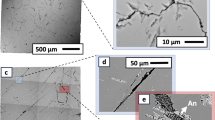Abstract
The natural occurrence of critical assemblages among the phases clinohumite, chondrodite, norbergite, tremolite, forsterite, brucite, periclase, diopside, calcite and dolomite, together with experimental and thermochemical data, permits the calculation of phase equilibria governing the stability of the humite group minerals in impure dolomitic limestones. The phase relations are described by 29 divariant (OH-F) continuous reactions, and 11 univariant discontinuous reactions. The equilibrium conditions for these reactions have been calculated and plotted in isobaricT-X(OH-F) andT- \(X_{CO_2 } \) phase diagrams. Continuous reactions govern the compositions of (OH-F) solid solutions and the consequent movement of three-phase triangles on the chemographic diagram. Discontinuous reactions result in the appearance or disappearance of a distinct phase assemblage. The pure OH-humite minerals are metastable relative to forsterite+brucite. With increasing fluorine content, clinohumite, followed in turn by chondrodite and norbergite, becomes stable. The stability fields for the individual humite minerals expand to more CO2-rich fluid compositions with increasing fluorine content and decreasing total pressure. At 1,000 bars, clinohumite can contain a maximum of 58 mole percent fluorine before reacting discontinuously to form chondrodite (X F=0.61) and forsterite. The stability field for clinohumite+calcite is restricted to fluids with\(X_{CO_2 } \)<0.40. At temperatures less than 700°C, the minimum fluorine mole fractions required to stabilize chondrodite and norbergite are 0.31 and 0.62 respectively. At the same conditions, chondrodite can contain a maximum of approximately 85 mole % F. The calculated phase equilibrium boundaries, the range of stable humite compositions and the compositions of coexisting (OH-F) phases are in good overall agreement with natural assemblages. Owing to steepdT/d \(X_{CO_2 } \) slopes for several of the humite continuous reactions, the F/(F+OH) ratio of a given humite mineral is a useful indicator of the CO2/H2O ratio of the fluid phase.
Similar content being viewed by others
References
Aoki A, Fujino K, Akaogi M (1976) Titanochondrodite and titanoclinohumite from the upper mantle in the Buell Park kimberlite, Arizona. Contrib Mineral Petrol 56:243–253
Becker P (1976) Klinohumite vom Laperwitzbach, Dorfertal, Osttirol. Karinthin 75:257–260
Bourne JH (1974) The petrogenesis of the humite group minerals in regionally metamorphosed marbles of the Grenville supergroup. Ph D Thesis, Queen's University
Burnham CW (1959) Contact metamorphism of magnesian limestones at Crestmore, California. Geol Soc Am Bull 70:879–920
Burnham CW, Holloway JR, Davis NE (1969) Thermodynamic properties of water to 1,000° C and 10,000 bars. Geol Soc Am Spec Pap 132
Duffy CJ (1977) Phase equilibria in the system MgO-MgF2-SiO2-H2O. Ph D Thesis, University of Britisch Columbia
Duffy CJ, Greenwood HJ (1979) Phase equilibria in the system MgO-MgF2-SiO2-H2O. Am Mineral 64:1156–1173
Gasparrini FL, Gittins J, Rucklidge J (1971) Chemical variation among the non-carbonate minerals of the Cargill Lake carbonatite, Ontario. (Abstr) Can Mineral 10:913
Jones NW, Ribbe PH, Gibbs GV (1969) Crystal chemistry of the humite minerals. Am Mineral 54:391–411
McGetchin TR, Silver LT, Chodos AA (1970) Titanoclinohumite: a possible mineralogical site for water in the upper mantle. J. Geophys Res 75:255–259
Moore JN, Kerrick DM (1976) Equilibria in siliceous dolomites of the Alta aureole, Utah. Am J Sci 276:502–524
Rice JM (1973) Phase equilibria and chemistry of metamorphosed impure dolomite, Ross Lake, Washington. Geol Soc Am Abstr Prog 5:96
Rice JM (1977) Contact metamorphism of impure dolomitic limestone in the Boulder aureole, Montana. Contrib Mineral Petrol 59:237–259
Rice JM (1980) Phase equilibria involving humite minerals in impure dolomitic limestones: Part I. Calculated stability of clinohumite. Contrib Mineral Petrol 71:219–235
Robie RA, Hemmingway BS, Fisher JR (1978) Thermodynamic properties of minerals and related substances at 298.15° K and 1 bar (105 pascals) pressure and at higher temperatures. US Geol Surv Bull 1452:456 pp
Skippen GB (1971) Experimental data for reactions in siliceous marbles. J. Geol 79:451–481
Skippen GB (1974) An experimental model for low pressure metamorphism of siliceous dolomitic marble. Am J Sci 274:487–509
Skippen GB, Yzerdraat W (1970) XCDFOR, A FORTRAN IV program for calculating mineral equilibria onT-X223-01 sections. Carleton Univ Geol Pap 1970
Struwe H (1958) Data on the mineralogy and petrology of the dolomite-bearing northern contact zone of the Querigut granite, French Pyrenees. Leidse Geol Meded 22:237–349
Thompson JB Jr, Norton SA (1968) Paleozoic regional metamorphism in New England and adjacent areas. In: Zen E-an (ed) Studies of Appalachian Geology: Northern and Maritime. Intersci, New York, pp. 319–327
Thompson JB Jr (1967) Thermodynamic properties of simple solutions. In: Abelson PH (ed) Researches in Geochemistry II. John Wiley and Sons, New York, pp 340–361
Thompson AB (1976) Mineral reactions in pelitic rocks: I. Prediction ofP-T-X(Fe-Mg) phase relations. Am J Sci 276:401–425
Tilley CE (1951) The zoned contact skarns of the Broadford area, Skye: A study of boron-fluorine metasomatism. Mineral Mag 29:621–660
Trommsdorf V (1966) Beobachtungen zur Paragenese Forsterit (Klinohumit, Chondrodit)-Klinochlor in metamorphen Dolomitgesteinen des Lepontins. Schweiz Mineral Petrogr Mitt 46:421–429
Trommsdorf V, Evans BW (1980) Titanian hydroxyl-clinohumite: Formation and breakdown in antigorite rocks. Contrib Mineral Petrol 72:242
Watanabe T (1943) Geology and mineralization of the Suian District, Tyosen (Korea). J Fac Hokkaido Univ Ser 4+6:3–4
Wenk E (1963) Klinohumit und Chondrodit in Marmoren der Tessiner Alpen und der Disgrazia Gruppe. Schweiz Mineral Petrogr Mitt 43:287–293
Author information
Authors and Affiliations
Rights and permissions
About this article
Cite this article
Rice, J.M. Phase equilibria involving humite minerals in impure dolomitic limestones. Contr. Mineral. and Petrol. 75, 205–223 (1981). https://doi.org/10.1007/BF01166761
Received:
Accepted:
Issue Date:
DOI: https://doi.org/10.1007/BF01166761




